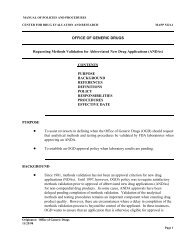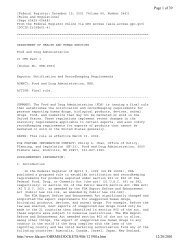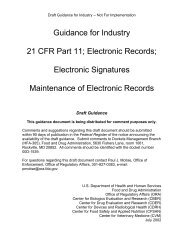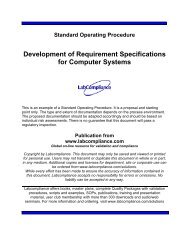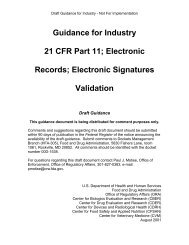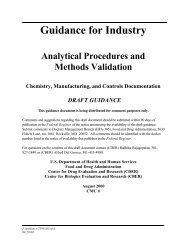Guidance for Off-The-Shelf Software Use in Medical Devices
Guidance for Off-The-Shelf Software Use in Medical Devices
Guidance for Off-The-Shelf Software Use in Medical Devices
You also want an ePaper? Increase the reach of your titles
YUMPU automatically turns print PDFs into web optimized ePapers that Google loves.
OTS <strong>Software</strong> Level of Concern: A corneal topographer represents no threat of direct harmto the patient. <strong>The</strong> risk of <strong>in</strong>direct harm from a misdiagnosis relat<strong>in</strong>g to medical devicemalfunction is small s<strong>in</strong>ce the worst case is an <strong>in</strong>correct image which is considered correct.<strong>The</strong> OTS <strong>Software</strong> <strong>in</strong> this medical device thus represents a M<strong>in</strong>or Level of Concern (seesection 2.2) and should satisfy BASIC DOCUMENTATION (see section 2.1).3.1.2 Per<strong>in</strong>eometer—M<strong>in</strong>or Level of Concern medical device (see Section 2.1)Intended <strong>Use</strong>: Per<strong>in</strong>eometers are used to provide feedback to a patient per<strong>for</strong>m<strong>in</strong>g musclestrengthen<strong>in</strong>g exercises (Kegel exercises) <strong>for</strong> the treatment of certa<strong>in</strong> types of ur<strong>in</strong>ary<strong>in</strong>cont<strong>in</strong>ence.Description: <strong>The</strong>re are two types of per<strong>in</strong>eometers: those which measure pressure, and thosewhich measure electrical activity (EMG) from muscles. Each device consists of a probethat is placed <strong>in</strong>to either the vag<strong>in</strong>a or the rectum, and a monitor<strong>in</strong>g unit. <strong>The</strong> pressuredevices use an air-filled probe connected to the monitor<strong>in</strong>g unit by a piece of plastictub<strong>in</strong>g. When the patient per<strong>for</strong>ms the exercise, the probe is compressed, and themonitor<strong>in</strong>g unit reports the change <strong>in</strong> pressure. <strong>The</strong> electrical devices use an electrode tomeasure the electrical activity of the target muscles dur<strong>in</strong>g the exercises, and this<strong>in</strong><strong>for</strong>mation is reported by the monitor<strong>in</strong>g unit.OTS <strong>Software</strong>: An OTS operat<strong>in</strong>g system, such as DOS or W<strong>in</strong>dows, may be used to recordand display the data collected by the monitor<strong>in</strong>g unit.OTS <strong>Software</strong> Level of Concern: Per<strong>in</strong>eometers represent no threat of direct <strong>in</strong>jury to thepatient, s<strong>in</strong>ce no energy is applied by the medical device to the patient. <strong>The</strong> risk of<strong>in</strong>direct <strong>in</strong>jury due to <strong>in</strong>accurate feedback dur<strong>in</strong>g the exercise session is expected to besmall, as these medical devices are only used as an adjunct to exercise therapy, and theyare used under cl<strong>in</strong>ical supervision. <strong>The</strong> OTS <strong>Software</strong> <strong>in</strong> this medical device thusrepresents a M<strong>in</strong>or Level of Concern (see section 2.2) and should satisfy the BASICDOCUMENTATION (see Section 2.1).3.1.3 Implantable <strong>Medical</strong> Device Programmers—Describe and Justify Residual Risk (see Section 2.5)Intended <strong>Use</strong>: An implantable medical device programmer provides <strong>in</strong>terface and two-waycommunication with an implantable cardioverter-defibrillator (ICD) or cardiac pacemaker.Description: An implantable medical device programmer consists of an electromagneticprogramm<strong>in</strong>g head which is placed over the implanted device and provides through-thesk<strong>in</strong>communication with the implanted device, the personal computer (PC) <strong>in</strong>terface, andthe PC hardware and software. <strong>The</strong> programmer permits the physician-user to:• query the implant <strong>for</strong> per<strong>for</strong>mance history (device and patient), and, <strong>in</strong> some systems,<strong>for</strong> pr<strong>in</strong>t-out of the recorded electrograms;OTS <strong>Software</strong> <strong>Guidance</strong>, F<strong>in</strong>al page 13




